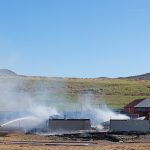CPW Commission approves emergency wolf hazing rules
Ranchers in Colorado can now haze gray wolves to protect livestock after the Colorado Parks and Wildlife Commission unanimously approved new emergency regulations on Wednesday, Jan. 12.
The new regulations were already being considered through the commission’s regular process, but Parks and Wildlife staff and commissioners felt recent wolf predation incidents warranted more immediate action.
“These techniques are designed to frighten or annoy gray wolves in order to dissuade them from preying on livestock or livestock guard animals,” said Krista Heiner, Parks and Wildlife regulations manager.
Before these new regulations ranchers didn’t have many options if a wolf was harassing livestock. Now they can use guard animals, fladry (colored flags on fencing), scare devices like propane cannons and range riders, as well as several non-lethal projectiles.
Hazing must not result in injury or death to a wolf, and if a rancher believes hazing techniques may have injured a wolf they must report the incident to Parks and Wildlife within 48 hours, the regulations say.
The new regulation would not apply to pets unless it was a true working animal, though Parks and Wildlife staff said they would generally err on the side of a livestock owner. Staff noted this regulation is both meant to protect livestock and, by way of avoiding conflicts, the wolves themselves.
“We’re talking about livestock right now and were talking about people that are in this, living this in real time,” said Parks and Wildlife commissioner Betsy Blecha, who represents sportspersons on the commission. “We don’t have all the answers because it’s happening every week in front of us.”
Commissioners and Parks and Wildlife staff noted that these regulations may change over time as the agency continues to plan the reintroduction of wolves in Colorado by the end of next year.
Wildlife advocates spoke favorably of the new regulations during public comment, saying measures that prevent encounters between livestock and wolves are beneficial to both.
Norman Bishop, a former national park ranger who was involved in the reintroduction of wolves to Yellowstone National Park in Wyoming, said he has observed how well many of these hazing techniques work.
Through 2020, Bishop said park staff recorded 55 wolves displaying habituated behaviors on 127 occasions. About half the time, hazing worked to change the behaviors. Another 42% of the time, the habituated behavior was determined to be an isolated event.
Hazing was unsuccessful in changing the behavior of six wolves, Bishop said. Hunters outside the park killed three, a car hit one and park rangers removed two more.
“130 million people have enjoyed the park in the 27 years since wolves were restored,” Bishop said. “No visitor has been hurt by a wolf.”
Attractants
The commission also approved a new regulation forbidding the use of olfactory, or scented, attractants to lure wolves.
Parks and Wildlife Director Dan Prenzlow said wildlife officers have had a few instances where people were trying to lure wolves this way, and the regulation was Parks and Wildlife’s response. Commissioners discussed banning luring wolves with any method, but Prenzlow said the agency’s intent was to respond to a specific problem.
“This is somewhat of a patch,” Prenzlow said, adding that broader discussions should be part of wolf reintroduction planning. “We’re trying to limit what we do in the interim so the commission can take all of this in totality into the future.”
To reach Dylan Anderson, call 970-871-4247 or email danderson@SteamboatPilot.com.

Support Local Journalism

Support Local Journalism
Readers around Steamboat and Routt County make the Steamboat Pilot & Today’s work possible. Your financial contribution supports our efforts to deliver quality, locally relevant journalism.
Now more than ever, your support is critical to help us keep our community informed about the evolving coronavirus pandemic and the impact it is having locally. Every contribution, however large or small, will make a difference.
Each donation will be used exclusively for the development and creation of increased news coverage.










